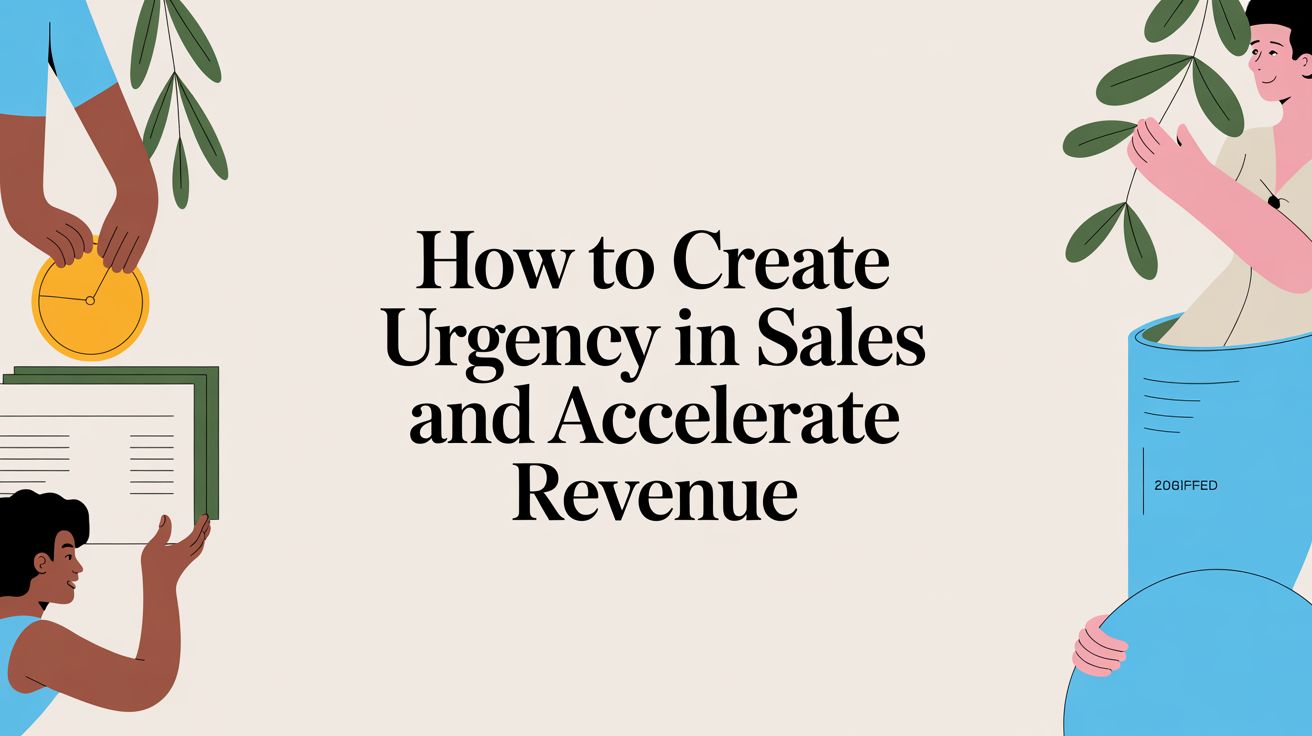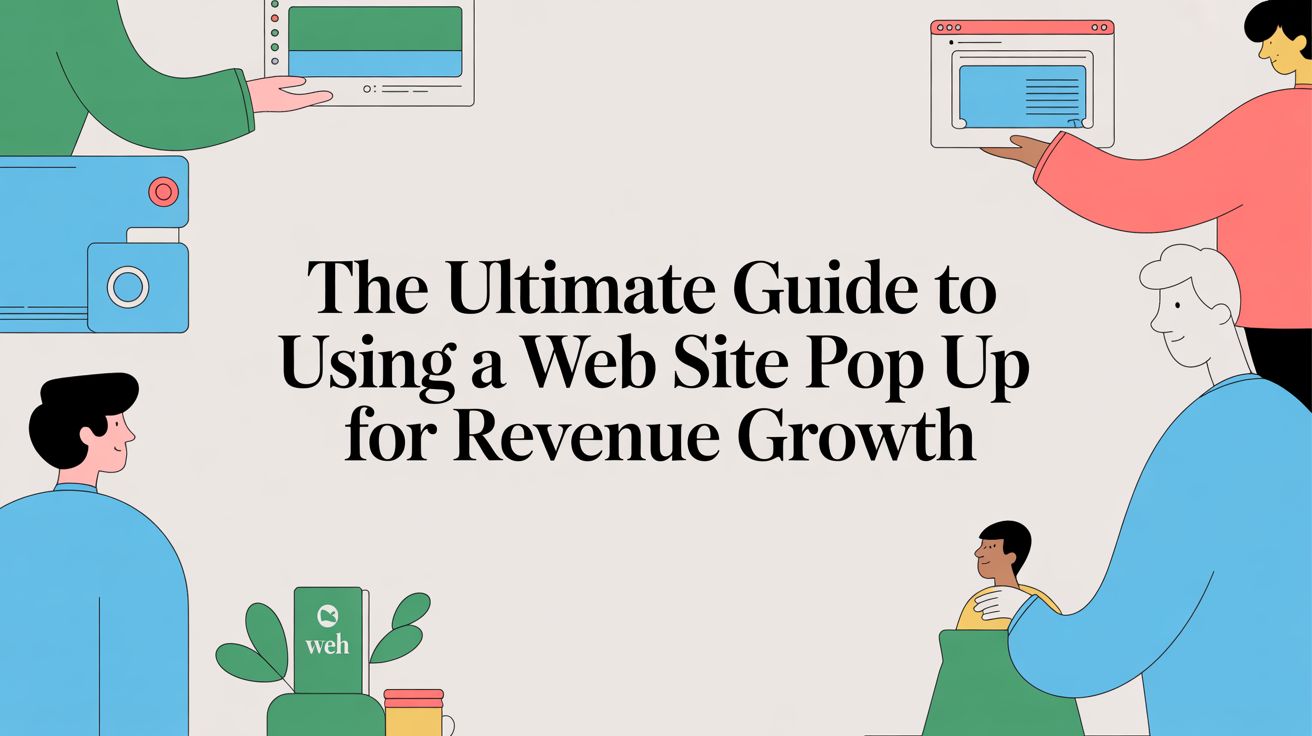
Fixing Abandoned Shopping Carts with Urgency Psychology
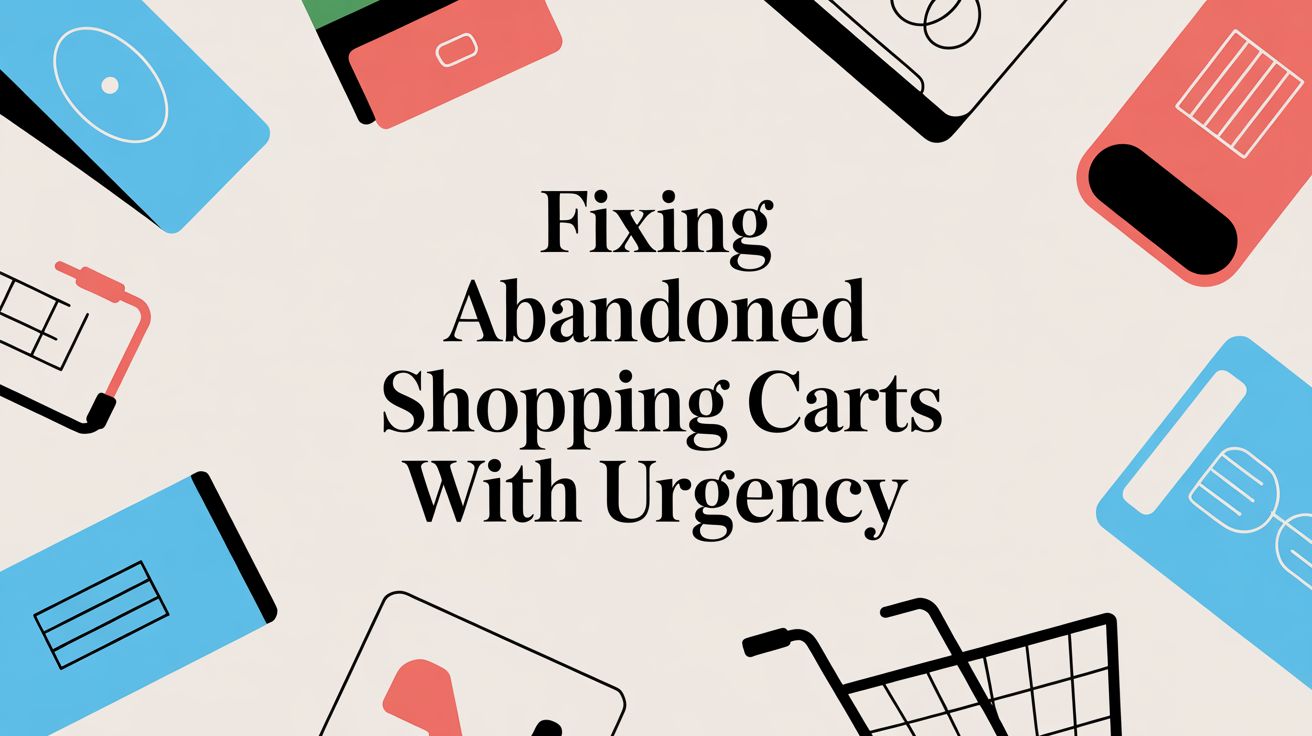
We've all done it. You find something you love online, add it to your cart, get to the checkout… and then something stops you. That moment of hesitation is what we in the e-commerce world call a "shopping cart abandonment."
It’s more than just a blip in your analytics or a missed sale. It’s a bright, flashing warning light indicating friction somewhere in your customer’s journey, and it’s one of the biggest sources of lost revenue for online brands.
The True Cost of Abandoned Shopping Carts
An abandoned cart isn't just a potential sale that vanished. It's a direct hit to your profitability that sends ripples across your entire business, impacting everything from marketing ROI to inventory planning.
The scale of this problem is genuinely staggering. The average cart abandonment rate across e-commerce is a whopping 70.19%. Think about that for a second. For every ten shoppers who show clear intent to buy, seven of them walk away empty-handed.
Globally, this adds up to an estimated $4 trillion in lost potential sales every single year. That’s a number so big it’s hard to wrap your head around, but it highlights just how critical it is to tackle this issue head-on. If you want to dig deeper, you can find more insights about these cart abandonment statistics and what they really mean for retailers.
This infographic helps put the sheer volume of lost revenue into perspective.
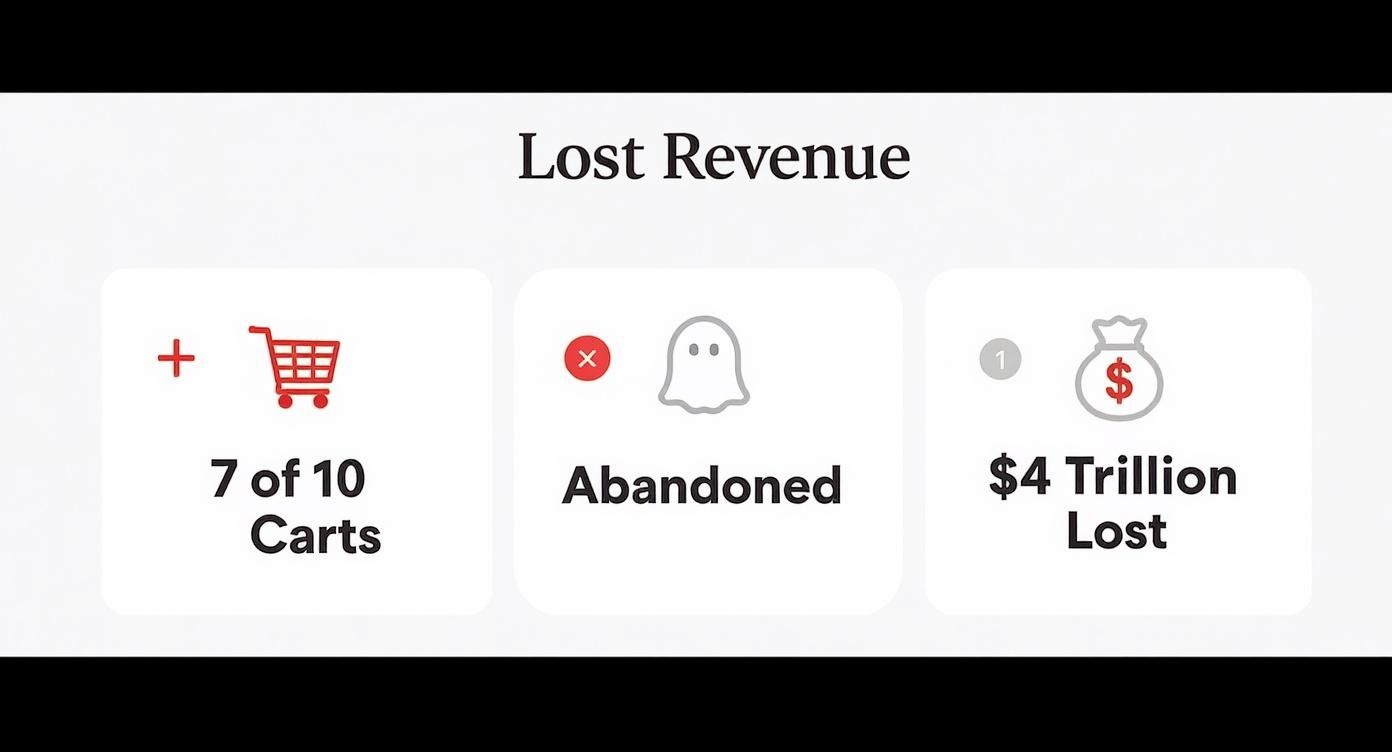
As you can see, those seven out of ten carts add up fast, contributing to trillions in missed opportunities for businesses just like yours.
But the damage doesn't stop with the initial lost sale. The secondary costs are just as painful, if not more so.
It Goes Deeper Than One Lost Sale
Every abandoned cart represents a customer you likely paid to get in the door. You spent money on ads, content, or social media to attract them, guide them to a product, and get them to click "add to cart."
When a shopper bails at checkout, the return on ad spend (ROAS) for that acquisition immediately drops to zero. This, in turn, inflates your overall customer acquisition cost (CAC) and puts a massive strain on your marketing budget to make up for the loss.
You end up in a frustrating cycle: spending money to attract shoppers who never actually buy, which directly eats away at your profit margins.
Chaos for Inventory and Forecasting
High abandonment rates also wreak havoc on your inventory management—a nightmare scenario, especially for Shopify Plus merchants juggling huge product catalogs. When items sit in abandoned carts, they can be temporarily held from stock, making them appear unavailable to other, more motivated buyers.
This creates a domino effect of operational headaches:
- Twisted Demand Data: Abandoned carts can create a false sense of demand for certain products, leading to wildly inaccurate sales forecasts.
- Overstocking Nightmares: If you order more inventory based on that faulty data, you risk getting stuck with overstock that you’ll have to sell off with margin-killing discounts.
- Wasted Capital: Money tied up in products that aren't actually selling is money you can't invest in your proven winners.
To help visualize how these checkout friction points connect to real-world consequences, let's break down the primary causes and their direct impact on your business.
Primary Causes of Cart Abandonment and Their Business Impact
This table connects the dots between why a shopper leaves and how it hurts your bottom line.
| Abandonment Reason | Psychological Driver | Direct Business Impact |
|---|---|---|
| Unexpected Costs (shipping, taxes, fees) | Sticker Shock & Betrayal | Loss of customer trust; increased Customer Acquisition Cost (CAC) as you pay to re-acquire them. |
| Complicated Checkout Process | Cognitive Overload & Frustration | Reduced conversion rates; inflated marketing spend with poor Return on Ad Spend (ROAS). |
| Account Creation Required | Privacy Concerns & Impatience | Higher bounce rates at a critical conversion point; missed sales from impulse buyers. |
| Slow Delivery Times | Need for Instant Gratification | Loss of sales to competitors with faster fulfillment (like Amazon); negative brand perception. |
| Lack of Payment Options | Payment Friction & Mistrust | Lower conversion rates, particularly among younger demographics who prefer digital wallets. |
| Website Performance Issues (slow, buggy) | Doubt & Annoyance | Damage to brand credibility; high bounce rates and complete session abandonment. |
| No Clear Return Policy | Risk Aversion & Uncertainty | Reduced customer confidence; lower Average Order Value (AOV) as shoppers hesitate to buy more. |
| Just Browsing / Saving for Later | Price Comparison & Indecision | Skewed demand forecasting and potential inventory shortages on high-intent items. |
Understanding these connections is the first step toward a solution.
Ultimately, you have to stop looking at abandoned carts as failures. Instead, see them for what they are: massive revenue recovery opportunities. By digging into the psychology behind shopper hesitation and using the right strategies, you can turn that indecision into action, protecting your revenue and building a stronger, more resilient business.
The Psychology Behind Shopper Hesitation
To truly tackle abandoned shopping carts, we have to go deeper than just pointing fingers at high shipping costs. There are powerful psychological forces at play. Shopper hesitation isn't just a random whim; it's a predictable reaction that’s rooted in how our brains are wired. When a customer hits the brakes at checkout, they're often wrestling with a few key mental triggers that create doubt and friction.

Figuring out what these drivers are is the first step. It's how you move from just sending reminder emails to building a revenue recovery strategy that actually motivates people to click "buy."
The Pain of Payment and Loss Aversion
One of the biggest hurdles is something psychologists call the pain of payment. This isn't just a metaphor; people feel a very real, tangible sting when they have to part with their money. Every dollar spent feels like a tiny loss, and our brains are programmed to avoid loss at all costs.
This feeling gets cranked up to eleven by unexpected costs. Think about it: a $50 item with a surprise $10 shipping fee at the end feels way worse than a $60 item with free shipping, even though the total is identical. Why? That last-minute fee feels like a trick, amplifying the pain of payment and triggering an immediate defensive reaction—closing the tab.
This all ties back to a core principle of behavioral economics: loss aversion. The pain of losing something is psychologically about twice as powerful as the pleasure of gaining something. An unexpected fee feels like a loss, and that makes the whole purchase suddenly feel a lot less exciting.
Decision Paralysis and Cognitive Friction
Today’s ecommerce world gives us endless choices, but that can easily backfire. When a shopper is faced with too many options—different product colors, multiple shipping speeds, a dozen payment methods—they can get hit with decision paralysis. The mental energy it takes to make the "perfect" choice just becomes too much, and it leads straight to procrastination. They tell themselves they’ll “decide later,” but later rarely comes.
This is a classic case of cognitive friction, where a confusing or complex process makes the user work too hard. A checkout that forces you to create an account, enter the same information twice, or navigate a maze of steps adds a ton of unnecessary mental load. Every extra field they have to fill out, every extra click they have to make, increases the odds they'll just give up.
The Human Tendency to Procrastinate
At our core, we're all natural procrastinators. Unless there's a really good reason to do something right now, our default setting is to wait. An abandoned cart is often just a symptom of that inertia. Without a clear and immediate incentive, the shopper sees no harm in putting off the purchase.
This gets worse when you add perceived risk into the mix. Shoppers are silently asking themselves:
- Is this product really going to be as good as it looks?
- Could I find a better price if I just look around a little more?
- What happens if I need to return it? Is it going to be a hassle?
A return policy that's confusing or buried somewhere on your site only adds to this risk, giving the brain yet another excuse to hit pause.
These are the exact psychological barriers that a smart urgency marketing strategy is built to overcome. By understanding the science behind hesitation, you can create the gentle, compelling nudge your customers need to turn their interest into your revenue. To see how these principles drive real conversions, you can dive deeper into consumer psychology and why urgency causes action.
Why Basic Cart Recovery Tactics Often Fail
Faced with staggering abandonment numbers, most brands reach for the same playbook: automated email sequences and exit-intent pop-ups. While these tools might nudge a tiny fraction of shoppers, they fail to address the core psychological reasons for hesitation and are losing effectiveness in a world of digital noise.
Relying on these tactics is like trying to fix a complex engine with a hammer. You are addressing a symptom, not the root problem, which is why the ROI on these basic automations is often disappointing.
These conventional methods fall flat because they ignore the why behind a shopper's hesitation. A generic "You left something in your cart!" email doesn't understand if the customer paused due to decision paralysis, sticker shock, or a simple lack of urgency. This one-size-fits-all approach results in low open rates and even lower revenue recovery.
The Problem with Generic Pop-ups and Timers
Many common recovery tools, especially basic apps on the Shopify store, focus on the wrong goal: email capture, not immediate revenue generation. An intrusive pop-up demanding an email just as a user is leaving adds more friction. At best, it's an annoyance; at worst, it damages brand perception.
Similarly, simple countdown timers slapped on a page without real context often feel manipulative. Modern shoppers are sophisticated; they can spot manufactured urgency from a mile away.
Behavioral economics research shows that for urgency to be effective, it must be believable. When a timer feels arbitrary and disconnected from a genuine reason—like a real inventory shortage or a limited-time event—it can erode trust and cheapen the brand experience.
This approach lacks the sophistication needed to tap into the real psychological drivers of cart abandonment. It’s the equivalent of shouting with a megaphone when what’s needed is an intelligent, one-on-one conversation.
Banner Blindness and The Low ROI of Basic Automation
Banner blindness is a psychological phenomenon where users subconsciously learn to ignore anything that resembles an advertisement, including generic pop-ups and on-site banners. Your well-intentioned reminder becomes invisible, lost in the visual clutter, which is why click-through rates are often so poor.
Furthermore, these basic tools often require significant manual effort to configure and manage, leading to a low return on your time. They fail to deliver where it counts most:
- Protecting Profit Margins: Generic pop-ups almost always default to offering a discount ("10% off to complete your order!"). This trains customers to abandon carts intentionally to get a coupon, directly eroding your margins.
- Improving Inventory Management: These basic alerts don't connect intelligently with your real-time stock levels. They cannot create urgency based on actual scarcity—a powerful psychological trigger that sophisticated systems use to drive immediate action and clear inventory.
In short, these tactics shout at the customer instead of communicating with them. True revenue recovery isn't about being louder; it's about being smarter. It means moving from one-dimensional triggers toward a strategy grounded in consumer psychology—creating timely, relevant, and compelling "Moments" that feel genuinely helpful, not intrusive.
Using Advanced Urgency to Drive Conversions
To truly combat cart abandonment, you must move beyond basic recovery tactics and leverage the behavioral science behind why people hesitate. This is where advanced urgency marketing shines. It's not about slapping a generic countdown timer on a page; it's about strategically applying proven psychological principles like scarcity, social proof, and FOMO to give shoppers a genuine, compelling reason to act now.
Instead of a one-size-fits-all approach, the goal is to create dynamic urgency moments that are a natural part of the shopper journey. By understanding and addressing the root causes of hesitation—like decision paralysis and risk aversion—you can turn indecision into decisive action and immediate revenue.
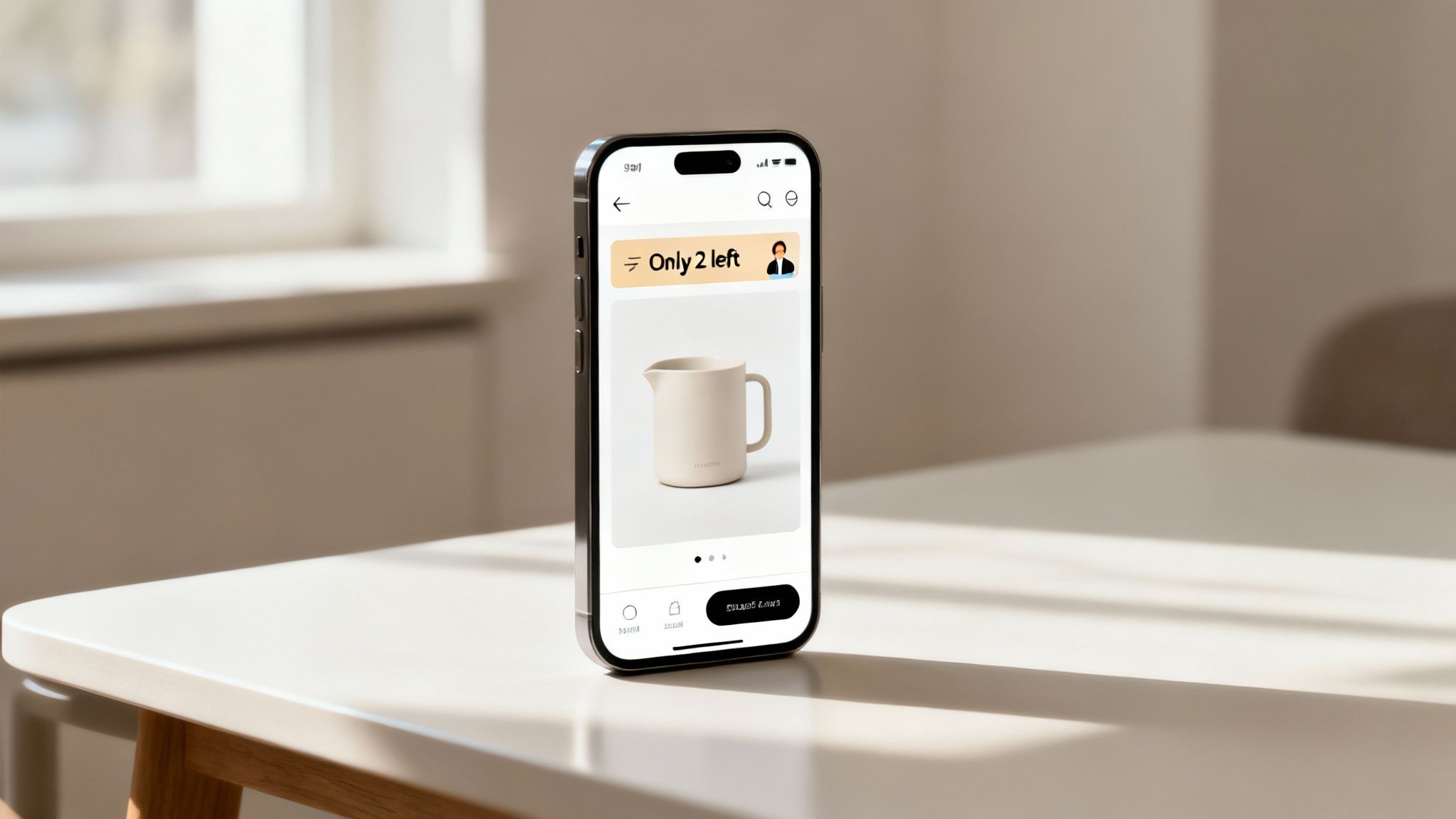
This smarter strategy is built on three core pillars of consumer psychology, and each one is designed to overcome a specific type of shopper hesitation.
Leveraging Scarcity to Overcome Procrastination
One of the most powerful psychological triggers is scarcity. Behavioral economics research consistently shows that when we perceive an item as limited, its value increases in our minds. This principle is the perfect antidote to procrastination, as carts are often abandoned simply because there's no reason to buy right now.
Advanced urgency marketing taps into real-time inventory data to create authentic scarcity—a world away from a fake timer.
- Low Stock Alerts: A simple message like "Only 3 left in stock!" on a product page creates a believable and powerful motivator. You are providing helpful information so customers can make an informed decision before the item is gone.
- Limited-Time Offers: Tying a promotion to a specific, short window makes the offer feel more valuable and nudges people toward checkout. This works especially well when integrated with platforms like Klaviyo or SMS tools to send timely notifications.
When scarcity is grounded in real-world constraints, you not only generate immediate sales but also improve inventory management by moving products faster.
Using Social Proof to Build Confidence
Much of shopper hesitation is fueled by uncertainty. Customers ask, "Is this the right product for me?" Social proof answers that question by showing that others have already made the same choice and are happy with it. This taps into our fundamental need for validation, making the purchase feel like a safer, less risky decision.
A study by the Baymard Institute found that 17% of users abandon checkout simply because of a lack of trust. Social proof directly fights this by building credibility and confidence at the most critical moment of the buyer's journey.
Intelligent banners and pop-ups can highlight social proof dynamically. For instance, a message like "25 people have bought this today" or "Trending item in your area!" cuts through decision paralysis by signaling that the product is a popular, trusted choice. It’s far more impactful than a generic email because it provides reassurance right when and where the customer needs it most.
Creating FOMO to Drive Immediate Action
The Fear of Missing Out (FOMO) is a potent psychological driver blending scarcity and social proof. It's the feeling that if you don't act now, you'll lose a unique opportunity that others are enjoying. This isn't about creating anxiety; it's about highlighting the exclusive value of completing a purchase right now.
Advanced platforms like Quikly excel at creating these "Moments" by moving beyond simple pop-ups, which primarily focus on email capture. Here, the focus is on generating revenue through intelligent, timely triggers.
| Tactic | Basic Approach (Low Impact) | Advanced Urgency (High ROI) |
|---|---|---|
| Limited Offer | A generic "10% off" pop-up. | A personalized offer that expires in a short, specific time frame, triggered by cart value. |
| Product Popularity | Static "Bestseller" badge. | A dynamic banner showing how many people are currently viewing or buying the item. |
| Inventory Scarcity | Fake countdown timer. | Real-time low stock alerts synced directly with your Shopify inventory levels. |
This sophisticated approach also helps protect profit margins by avoiding deep, unnecessary discounts. Instead of throwing a coupon at every visitor, you create a compelling reason for them to pay full price. To see how these principles can be applied directly to your store, explore these powerful Shopify urgency tactics and start turning that hesitation into revenue.
How to Implement Urgency Triggers on Shopify
Let’s move from theory to action. This is where you turn psychological insights into measurable revenue. For Shopify and Shopify Plus merchants, implementing advanced urgency triggers is about strategically weaving intelligent "Moments" into the customer journey, not just adding another generic app. We're moving beyond basic pop-ups to build a smart system that reduces abandoned shopping carts and boosts your bottom line.
The first step is identifying high-impact touchpoints in your shopper’s experience. Forget a blanket approach. Instead, focus on the specific pages where hesitation occurs most, as this is where a psychological nudge will be most effective.
Strategic Placement of Urgency Banners
Your product and cart pages are prime real estate. A shopper on a product page is clearly interested but likely comparison shopping. This is the perfect moment to introduce scarcity and social proof. Using a platform like Quikly, you can set up dynamic banners that pull real-time data from your Shopify backend.
For instance, a banner stating "Only 4 left in stock!" creates a genuine sense of scarcity that a simple countdown timer cannot match. It’s a powerful psychological nudge grounded in actual inventory. Similarly, a message like "17 people have this in their carts right now" uses social proof to build confidence and help shoppers overcome "should I or shouldn't I" paralysis.
Actionable Takeaway: Implement a low-stock alert banner on your top 5 product pages. Sync it to your live inventory to ensure the scarcity is authentic. This makes urgency feel like helpful, insider information, not a sales gimmick, protecting profit margins by reducing the need for discounts.
Configuring Revenue-Focused Pop-Ups
Most pop-ups are built for email capture and often add friction at the worst possible time. A smarter approach rethinks the pop-up as a revenue generation tool triggered by specific user behavior.
Imagine a shopper with over $100 in their cart moves their mouse to close the tab. Instead of a generic "Don't go!" message, an automated trigger can display a specific, time-sensitive offer, like free shipping that expires in 15 minutes. This creates a powerful incentive tied directly to completing the sale. While a simple countdown can be a start, you can explore this strategy further in our guide on the best ways to use a countdown timer on Shopify.
Integrating with Your Existing Tech Stack
Your urgency marketing shouldn't operate in a silo. Real power comes from connecting these triggers to your existing marketing platforms. For Shopify merchants, this means seamless integration with tools like Klaviyo for email and Attentive or Postscript for SMS.
This creates a unified, multi-channel experience:
- On-Site Trigger: A shopper sees a low-stock alert on your website.
- Cart Abandonment: They add the item to their cart but get distracted.
- Automated Follow-Up: A workflow is automatically triggered, sending an email via Klaviyo and an SMS message reminding them the item is about to sell out.
This cohesive system ensures your message is reinforced across channels. Of course, urgency is just one piece of the puzzle. A well-rounded approach to Shopify conversion rate optimization can make an even bigger impact on your store's ability to maximize conversions from your existing traffic.
There is no silver bullet for fixing abandoned carts. The reasons a shopper leaves are wildly different depending on the product and their location. Understanding these differences is the first step toward building a recovery strategy that actually gets results.
Someone buying a fast-fashion top has a different mindset than someone booking a flight or restocking groceries. Each industry has its own rhythm—a unique customer journey, consideration period, and psychological triggers. A one-size-fits-all approach to urgency is destined to fail.
High-Consideration vs. High-Frequency Buys
It makes sense that industries built on high-consideration purchases—where customers compare options—see higher abandonment rates. For these sectors, a more delicate touch is needed when creating urgency.
The numbers tell the story. The fashion industry often sees abandonment rates climb as high as 84.41%, as shoppers use carts as wishlists while comparing styles. The travel sector faces an even tougher challenge, with abandonment hitting nearly 87%, often due to complex booking processes. On the other end, essentials like groceries have lower rates, around 50%–57%, because these are routine purchases. You can dig deeper into these industry abandonment rates and what they mean.
This data shows that the why is different. The psychological reason for bailing on a fashion purchase (often decision paralysis) is a world away from the reason in travel (usually sticker shock).
Why You Need an Adaptive Strategy
Understanding these industry quirks is key to creating an urgency strategy that feels smart and effective. A low-stock alert might work wonders for limited-edition sneakers but will feel out of place for a digital subscription. The social proof that nudges a beauty customer won't resonate with someone buying B2B software.
The most successful brands don't just use urgency; they tailor it. When you adapt your triggers to the specific mindset of your industry’s shopper, you stop sending generic reminders and start creating sophisticated, behavior-driven moments that feel helpful, not pushy.
This is where more advanced platforms like Quikly come into play, giving merchants the power to build flexible campaigns that make sense for their specific market. Once you accept that shopper psychology isn't a monolith, you can build a recovery system that respects the customer's journey and does a much better job of turning "I'm thinking about it" into "I bought it."
A Few Lingering Questions About Cart Abandonment
Diving into the world of abandoned carts can bring up many questions. Let's tackle some of the most common ones merchants ask when trying to win back those almost-lost sales.
What Is a Good Cart Recovery Rate?
It's tempting to look for a magic number, but a "good" recovery rate isn't one-size-fits-all. While the average ecommerce conversion rate usually sits around 2.5%, industry chatter often points to 10% to 15% as a solid benchmark for recovery.
However, that number can swing wildly based on your industry, product price point, and the sophistication of your recovery efforts. A better goal is to focus on continuous improvement over your own baseline. Moving your recovery rate up even a few percentage points can translate into significant revenue. Swapping generic emails for tactics based on real psychology can often double or triple your results.
How Much Does Mobile Optimization Matter?
It is everything. Mobile commerce is no longer just a slice of the pie; for many brands, it is the pie. A clunky, frustrating mobile checkout is one of the fastest ways to lose a sale.
From the shopper's perspective, trying to navigate tiny buttons, endless zooming, and confusing forms on a phone is a conversion killer. Today, a seamless, responsive design that makes mobile purchasing effortless isn't just a nice-to-have; it's fundamental to protecting your bottom line.
Actionable Takeaway: Go through your own mobile checkout process from start to finish. If it takes more than 90 seconds or requires you to pinch-and-zoom, it's too complicated. Identify one point of friction and fix it this week.
Can Urgency Marketing Feel Manipulative?
This is an excellent question. The short answer is yes, it can—if done poorly. Tactics like fake countdown timers or baseless "limited stock!" banners feel disingenuous because they aren't real. Shoppers are savvy and can spot manufactured urgency, which erodes trust.
But that is not what sophisticated urgency marketing is about. When grounded in real behavioral science, it's about providing customers with helpful, genuine information to make better decisions. For example:
- Real Scarcity: Letting a customer know there are only three items left isn't pressure; it's a helpful heads-up so they don't miss out.
- Authentic Social Proof: Showing that 25 other people bought an item today provides valuable context. It signals that they're considering a popular item, which is useful information.
When you use urgency ethically, you respect the customer. You provide the information they need to act, turning a moment of potential hesitation into a helpful, positive nudge.
Ready to turn shopper hesitation into immediate revenue? See how Quikly uses the science of urgency marketing to recover abandoned carts and boost your bottom line. Learn more at https://hello.quikly.com.

The Quikly Content Team brings together urgency marketing experts, consumer psychologists, and data analysts who've helped power promotional campaigns since 2012. Drawing from our platform's 70M+ consumer interactions and thousands of successful campaigns, we share evidence-based insights that help brands create promotions that convert.
